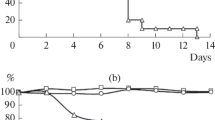Summary
Certain biological properties of an influenza A virus variant, obtainedin vivo from the lung tissue of mice infected with A-PR 8 influenza virus and treated with Xenalamine, have been studied. This drug-induced variant (DIV) has the following properties:
-
1.
it lacks pathogenic and hemagglutinating activity and shows interference capacity and infectious activity in embryonated chicken eggs and in mice; it also shows immunizing capacity in mice;
-
2.
its optimum transmissibility is found in the allantoic cavity of embryonated chicken eggs; the multiplication of the DIV in the chorioallantoic membrane is accompanied by the production of an interfering factor, which can be separated by ultracentrifugation from the virus particle, and, unlike the virus particle, is resistant to heating at 56° C for 30 minutes and is not neutralized by anti-DIV serum;
-
3.
it is lost on storage for 24 hours at 37° C and for 48 hours at 20° C;
-
4.
while it shares many antigens with the parent A-PR8 virus, it has an antigen or antigens not present in the parent virus and possesses only very little or entirely lacks other antigens present in A-PR8.
These characteristics give the DIV a new and distinct pattern among the biological variants of influenza virus.
Similar content being viewed by others
References
Altucci, P., F. Coraggio, G. Lorenzutti, V. Pecori, U. Sapio, eG. Tarro: Definizione dell'attività diretta dello Xenaldiale nei riguardi di vari virus „In vitro“. G. Microbiol.9, 186 (1961a).
Altucci, P., F. Coraggio, G. Lorenzutti, U. Sapio, eG. Tarro: Analisi del meccanismo d'azione di un derivato chetoaldeidico del difenile, lo Xenaldiale, sulle fasi di sviluppo endocellulare del virus influenzale A-PR 8 in uova embrionate e deembrionate di pollo. Boll. Ist. Sieroter. milan.40, 626 (1961b).
Altucci, P., G. Lorenzutti, etU. Sapio: Expérimentation virologique in vitro de dérivés cétoaldehydiques du diphényle et de composés relatifs, avec molecules support différentes, particulièrement sous l'aspect de leur mécanisme d'action. III Symp. Int. Chemother. Stuttgart 1963, (Thieme Verlag) Proc. I, 832, (1964).
Altucci, P., F. Coraggio, etV. Pecori: Il prednisolone ed i suoi derivati nelle infezioni virali sperimentali in culture di cellule in vitro e in vivo nel topo. G. Mal. infett.14, 403 (1962).
Magrassi, F., P. Altucci, G. A. Buonanno, G. Lorenzutti, eU. Sapio: Studi su di un farmaco (derivato chetoaldeidico del difenile) attivo nelle infezioni da virus epatitico del topo. Fisionomia della dinamica del processo infettivo da virus MHV-3 ceppo Craig nel topo e destino del virus negli organismi trattati con tale farmaco. G. Microbiol.8, 219 (1960).
Magrassi, F., P. Altucci, G. A. Buonanno, G. Lorenzutti, Y. Pecori, etU. Sapio: Nuovi farmaci antivirali: loro attività in diverse infezioni virali sperimentali. G. Mal. infett.13, 264 (1961).
Magrassi, F., G. Cavallini, andE. Massarani: Drugs active against influenza virus infection in mice. Arch. ges. Virusforsch.10, 9 (1962).
Magrassi, F., P. Altucci, A. R. Bianco, M. Coltorti, G. Coraggio, A. Di Simone, G. Lorenzutti, G. Mazzacca, Y. Pecori, U. Sapio, andV. Villari: Studies on new synthetic antiviral drugs, ketoaldehydic derivatives of biphenyl: virological aspects in experimental and clinical fields. II Int. Symp. Chemot., Naples 1961 (Karger). Proc. II, 50, (1963a).
Magrassi, F., P. Altucci, G. Lorenzutti, andU. Sapio: Some biological aspects of “mutilated virus” obtained by the action of ketoaldehydic derivatives of biphenyl in A-PR8 influenza virus infection “in vivo”. II Int. Symp. Chemother., Naples 1961, (Karger). Proc. II, 299 (1963, b).
Magrassi, F., P. Altucci, G. P. Jori, G. Lorenzutti, U. Sapio, etG. Tarro: Recherches sur le mécanisme d'action d'un groupe de médicaments à activité antivirale (produits cétoaldéhydiques du diphényle et leur dérivés): facteurs qui interfèrent sur leur activité protectrice in vivo. Relat. III Symp. Int. Chemother., Stuttgart 1963, (Thieme Verlag) Proc. I, 789 (1964).
Maisel, J., G. Moscovici, andM. La Placa: Susceptibility of human tumor cells to ECHO viruses and loss of hemagglutinating capacity of some of the adapted viruses. Arch. ges. Virusforsch.11, 209 (1961).
Philipson, L.: The early interaction of animal viruses and cells. Progr. med. Virol.5, 43 (1963).
Sabin, A. B., andE. L. Buescher: Unique physico-chemical properties of Japanese B Encephalitis virus hemagglutinin. Proc. Soc. exp. Biol. (N.Y.)74, 222 (1950).
Author information
Authors and Affiliations
Additional information
This work has been supported by a grant (Virology group) from the Italian National Research Council.
Rights and permissions
About this article
Cite this article
Magrassi, F., Altucci, P., Jori, G.P. et al. Properties of an avirulent influenza A virus variant derived from drug-treated mice infected with PR8 virus. Archiv f Virusforschung 18, 422–432 (1966). https://doi.org/10.1007/BF01246574
Received:
Issue Date:
DOI: https://doi.org/10.1007/BF01246574



